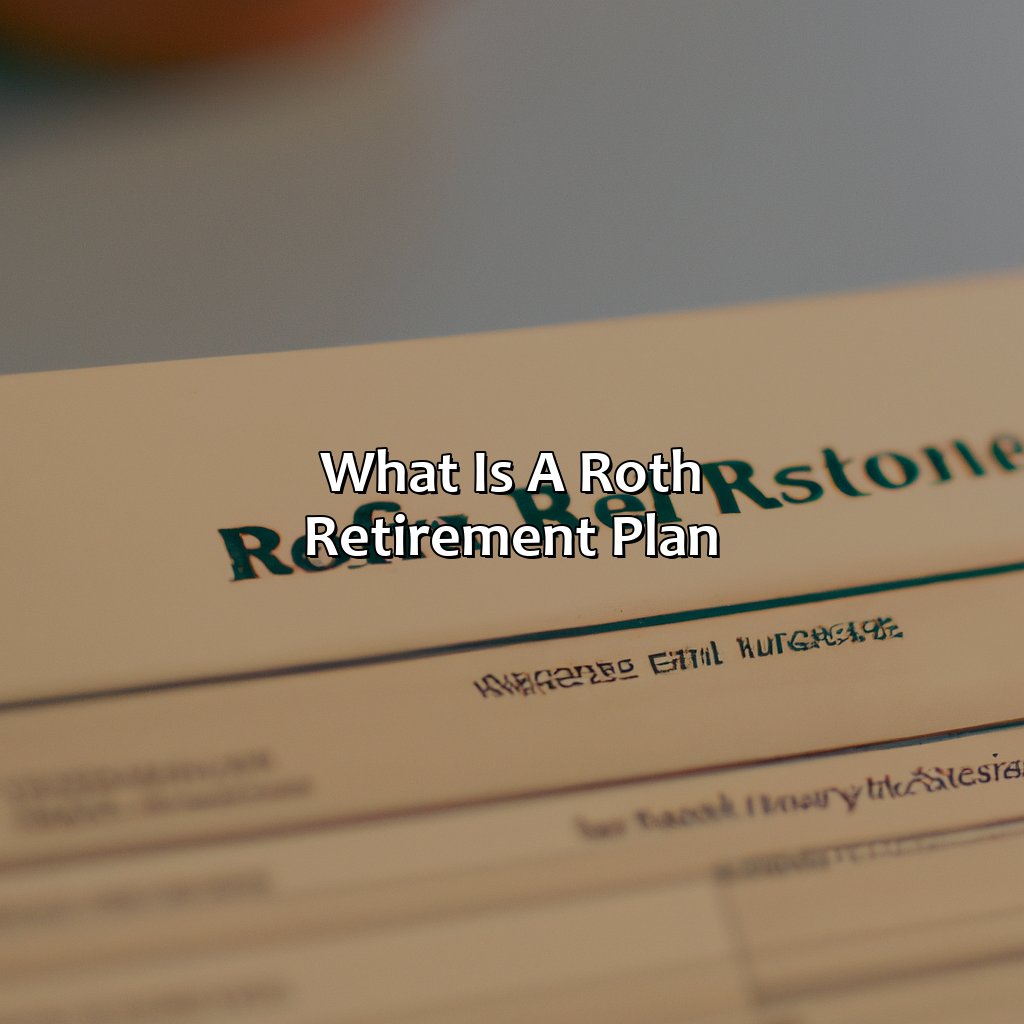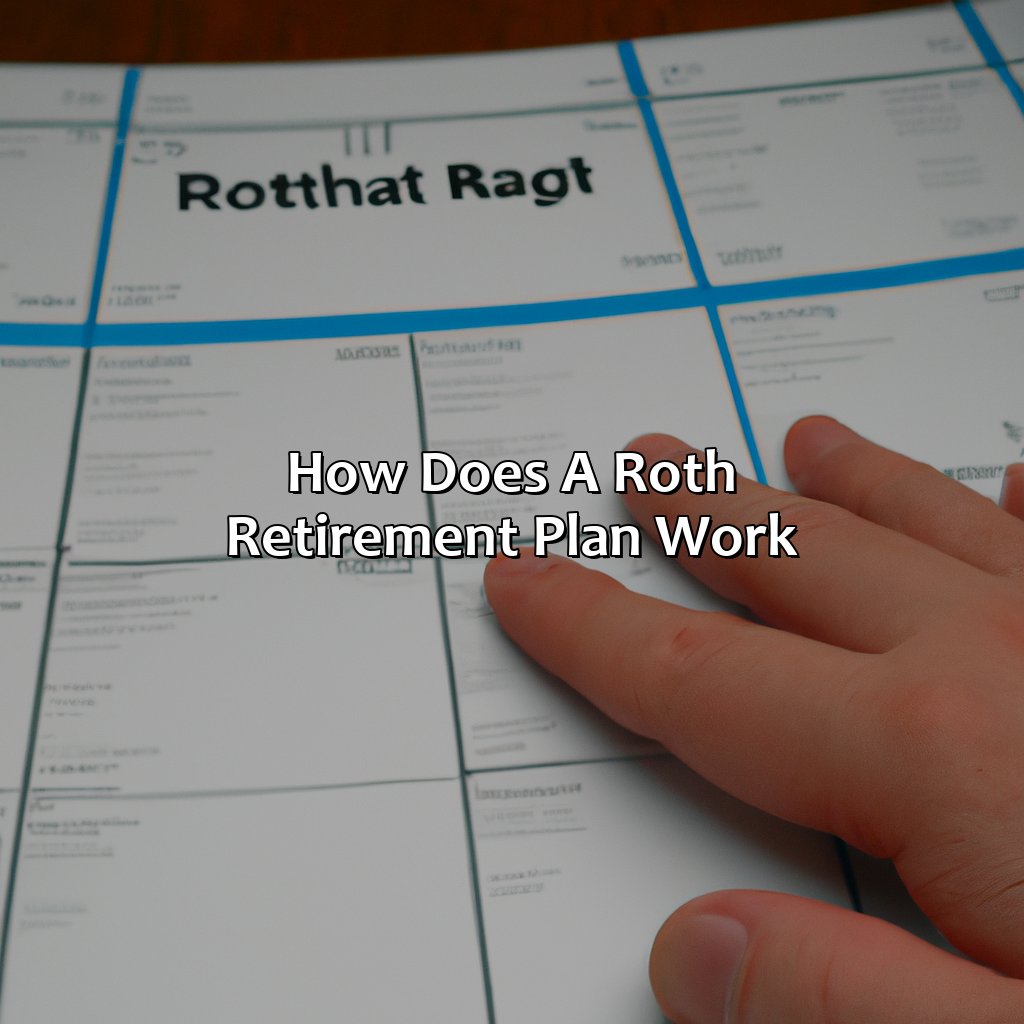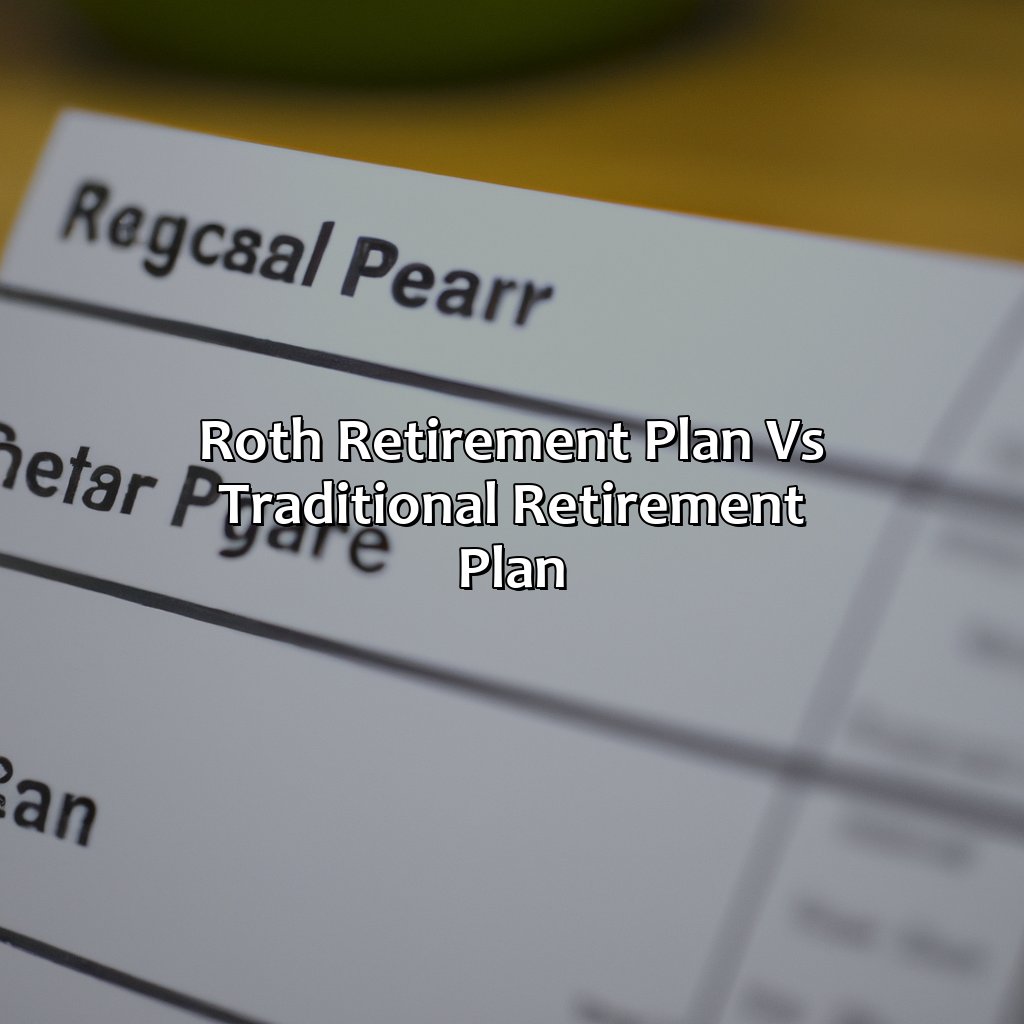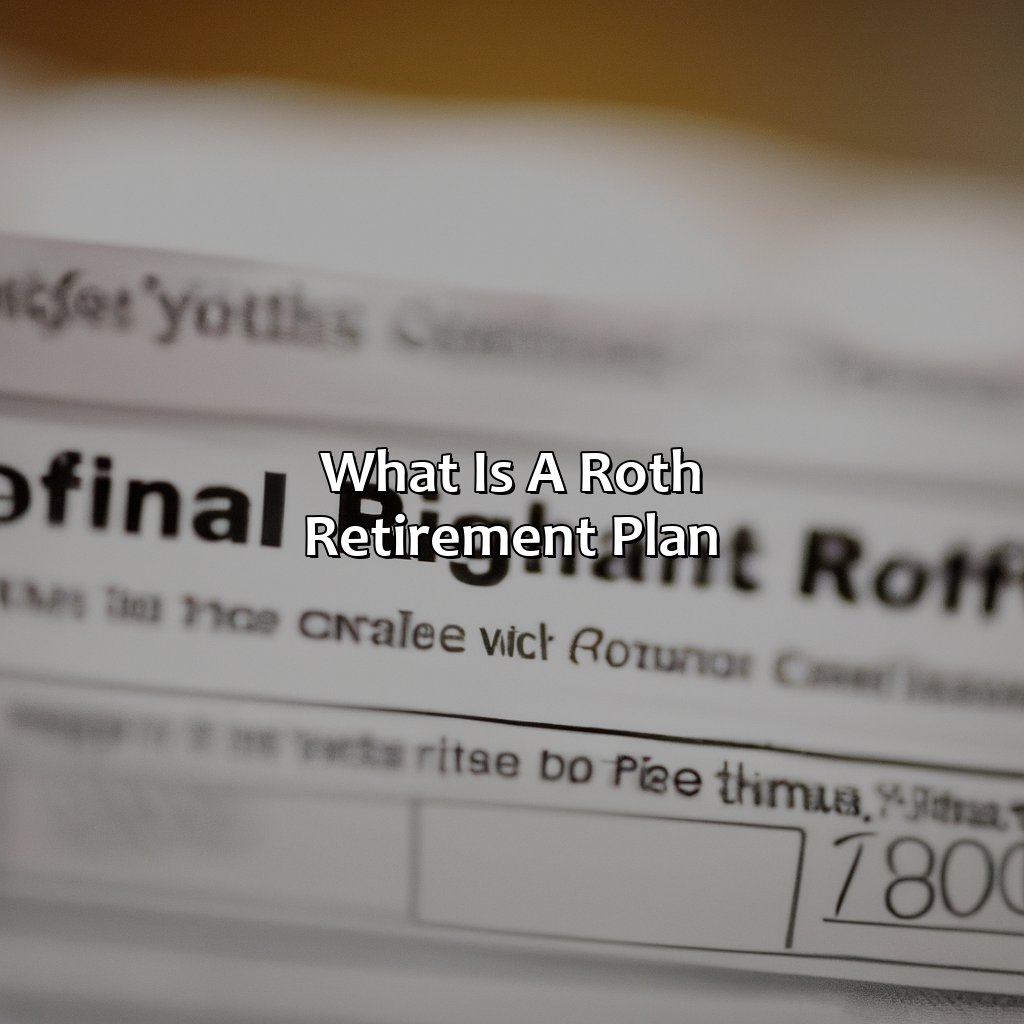What Is A Roth Retirement Plan?
Key Takeaway:
- A Roth Retirement Plan is a type of retirement account that allows individuals to make after-tax contributions in exchange for tax-free withdrawals during retirement.
- One of the benefits of a Roth Retirement Plan is that individuals have flexibility when it comes to taking withdrawals, as they are not required to start taking distributions at a certain age.
- When comparing a Roth Retirement Plan to a Traditional Retirement Plan, one key difference is that contributions to a Roth account are made on an after-tax basis, while contributions to a Traditional account are made on a pre-tax basis.
Are you confused about saving for retirement? Don’t worry, a Roth IRA can help you meet your retirement goals and provide tax advantages. With this article, you will gain insight on the basics of a Roth retirement plan.
What is a Roth Retirement Plan?
Do you want to understand a Roth Retirement Plan? You need to know the meaning and definition. Plus, find out its features and benefits. This section will help you learn both. Decide if it’s the best retirement solution for you!

Image credits: retiregenz.com by Adam Arnold
Meaning and definition of Roth Retirement Plan
A Roth Retirement Plan is a type of retirement savings account where contributions are made with after-tax income, and qualified withdrawals are tax-free. This plan is not subject to mandatory withdrawal at a certain age, giving it additional flexibility.
Roth Retirement Plans were introduced in 1997 as part of the Taxpayer Relief Act. Contributions can be made on an annual basis up to a set limit, and individuals who meet specific income requirements can contribute funds.
One unique feature of the Roth Retirement Plan is that contributions can continue to be made after reaching the age of 70 and a half, unlike Traditional IRAs. Additionally, if needed, contributions can be withdrawn without any penalties or taxes.
According to the Internal Revenue Service (IRS), as of 2021, individuals under 50 years old can contribute up to $6,000 annually. Those over 50 years old can make catch-up contributions up to $1,000 per year.
It’s essential to choose retirement savings plans wisely according to one’s financial situation and goals. The Roth Retirement Plan could be a beneficial option for those looking for tax-free growth and distribution options in later years.
Say goodbye to Uncle Sam taking a bite out of your retirement savings with a Roth plan that even the IRS can’t resist.
Features and benefits of Roth Retirement Plan
Roth Retirement Plan Explained – Unlocking its Advantages
Roth Retirement Plan is a tax-advantaged investment account that allows people to save for their retirement while avoiding taxes on withdrawals. Here are some of the unique benefits of Roth Retirement Plan:
- Tax-Free Withdrawals: Withdrawals from Roth Retirement Plan are tax-free, which means you get to keep all your hard-earned money. Unlike traditional plans, you don’t have to pay taxes on your withdrawals in retirement.
- No Required Minimum Distributions (RMDs): You’re not required to take distributions at any age, unlike many other retirement accounts. This allows you to maintain control over your investments and preserve the tax-free status as long as possible.
- No Age Limits: People of all ages can contribute to a Roth Retirement Plan if they meet income requirements. It’s never too late to start saving for retirement!
What sets Roth Retirement Plan apart from other retirement accounts is that it has no age limits, no RMDs and tax-free withdrawals. This makes it an ideal choice for anyone who wants more control over their retirement savings and greater flexibility in their Golden Years.
Don’t miss out on the opportunity to invest in your future with a Roth Retirement Plan. Take action now and start saving today!
Get ready to flex those financial muscles and learn how a Roth Retirement Plan can bench-press your retirement savings to new heights.
How does a Roth Retirement Plan work?
To get the hang of a Roth Retirement Plan, it’s important to be aware of key points. Contributions, withdrawals, taxes… consider these for a successful navigation. Eligibility criteria are also essential for devising your retirement plan.

Image credits: retiregenz.com by Adam Woodhock
Contributions, withdrawals, and taxes in Roth Retirement Plan
In a Roth Retirement Plan, contributions are made after-tax and tax-free withdrawals can be made in retirement. Here’s an overview of its unique features:
| Contributions | Made with after-tax dollars. |
| Withdrawals | Tax-free if you’re at least 59½ years old and have had the account for five years or more. |
| Taxes | No taxes are due on qualified distributions. |
It’s important to note that Roth IRA contributions are subject to income limits and there are annual contribution limits as well. Additionally, converting traditional IRAs to Roth IRAs is subject to income taxes.
Pro Tip: A Roth Retirement Plan may provide tax diversification when used in combination with other retirement savings vehicles.
If you’re old enough to take advantage of a Roth Retirement Plan, congratulations on surviving the internet and all its clickbait.
Eligibility requirements for Roth Retirement Plan
To be eligible for a Roth Retirement Plan, individuals must have taxable income and meet specific income requirements. They cannot exceed certain limits, which vary depending on marital status and filing status. Additionally, contributions cannot exceed a specific amount based on age.
Furthermore, the Roth IRA has no minimum required distribution at any age once funded. However, contributions are limited to earned income and not investment income. Individuals can also convert funds from a traditional IRA to a Roth IRA but will need to pay taxes on the converted amount.
Contrarily, the income limits for converting funds from a traditional IRA to a Roth IRA have been eliminated starting 2010, allowing anyone regardless of their account balance or income to make this conversion.
In summary, meeting both the age requirement and ensuring that contributions do not exceed allowable amounts are critical eligibility factors for opening and maintaining a Roth Retirement Plan. Individuals should consult with financial advisors for guidance and strategies in creating an optimal retirement portfolio that fits their unique circumstances.
Choosing between a Roth and Traditional Retirement Plan is like deciding between eating kale or cake – one is good for you, but the other is just so darn tempting.
Roth Retirement Plan vs Traditional Retirement Plan
Understand the difference between Roth and Traditional Retirement Plans by exploring their benefits. Breakdown each sub-section. Then, you can decide which plan is best. Consider these factors when choosing the right retirement plan:
- Roth Retirement Plans
- Tax benefits: Contribution to Roth plans are made after tax. Therefore, withdrawals in retirement aren’t taxed as income.
- No RMD: Unlike traditional IRAs, Roth IRAs don’t require withdrawals when the account owner turns 72, making it easier for account owners to retain profits.
- Flexible: Contributions can be withdrawn anytime penalty-free. However, withdrawing all earnings within five years of the contribution incurs a penalty.
- No age limit: Roth accounts don’t have a mandatory age for mandatory contributions.
- Traditional Retirement Plans
- Tax benefits: Contribution to traditional pre-tax plans reduces the tax liability, as the money is deducted from the taxable income.
- RMD: Traditional retirement plans mandate required minimum distributions after the person turns 72, even if they don’t need the money
- Early withdrawal penalty: Withdrawals before the age of 59 and a half incur a 10% early withdrawal penalty along with income taxes on the money withdrawn.

Image credits: retiregenz.com by Harry Jones
Differences between Traditional and Roth Retirement Plans
Traditional vs Roth Retirement Plans
A Roth retirement plan differs from a traditional retirement plan in several ways.
Below is a table outlining the differences between these two popular options:
| Traditional Retirement Plan | Roth Retirement Plan |
|---|---|
| Tax-deductible contributions | No tax deductions at contribution time |
| Taxes paid upon withdrawal | No taxes charged upon withdrawal |
| Required Minimum Distributions (RMDs) | No RMDs |
| Income limits for contributions | No income limits for contributions |
Apart from the above, there are additional unique details that make each retirement plan distinct from one another.
Putting all your savings into a Roth may not be the best option for everyone, but it has its advantages.
According to Forbes.com, as of 2021, individuals under the age of 50 can invest up to $6,000 annually in an IRA account.
It’s essential to learn more about each type of investment choice and speak to a financial advisor before making any decisions on where to invest your hard-earned money.
Retirement planning is like a game of chess, but with added pressure to not end up as a pawn in your own golden years.
Choosing the right retirement plan- factors to consider
Read on to discover the decisive factors for selecting the appropriate retirement plan. These considerations can affect your finances after retirement, thus making it essential for you to choose carefully.
- Assess your current income bracket
- Consider annual income growth potential
- Evaluate your predicted tax bracket post-retirement
When choosing a retirement plan, also consider options which enable flexibility and accessibility while ensuring security. Take into account key factors such as long-term goals and family dynamics.
Pro Tip: Seeking professional advice when making this decision can benefit you financially in the long run.
Choose Roth if you want to retire in style, or Traditional if you want to keep living like a starving student.
Summary of Roth Retirement Plan and its benefits
The Roth Retirement Plan – Explained and its benefits
A Roth retirement plan is a type of investment account designed to save for retirement. Unlike a traditional retirement plan, which takes pre-tax contributions, this account is funded with after-tax dollars. Here are some benefits of a Roth Retirement Plan:
- Tax-free withdrawals: No taxes on qualified withdrawals in retirement.
- No Required Minimum Distributions (RMDs): There are no required minimum distributions with a Roth IRA. You can leave the money in the account until you need it.
- Flexibility: Contributions can be withdrawn at any time without penalty or taxes.
- Estate planning tool: Roth IRAs can be passed down tax-free to heirs.
- Contribution flexibility: You can continue contributing to your Roth IRA as long as you have taxable income.
One unique aspect of the Roth retirement plan is its income eligibility requirements. Unlike other retirement accounts, there are income limits that affect your ability to contribute directly to a Roth IRA annually.
To maximize your retirement savings, consider opening and contributing regularly to a Roth investment account, even if you’re already contributing through an employer-sponsored 401(k) or 403(b) plan.
Take charge of your financial future today by exploring the benefits of investing in a Roth Retirement Plan. Don’t miss out on tax-free growth potential for your retirement years!
Importance of planning for retirement with appropriate retirement plans
Planning for retirement is crucial, and selecting the right retirement plan is pivotal for a comfortable life after retirement. A well-chosen retirement plan provides financial stability to retirees.
There are various types of retirement plans based on income, age, & job type. Retirement planning helps one estimate how much they should save before their desired retirement date.
Having a diverse investment portfolio is advantageous when planning for retirement. Scheduled contributions to a Roth IRA can gratify future needs; it offers tax-free growth and tax-free withdrawals in the future.
Anne retired with significant savings despite not earning a six-figure income since she planned her finances with appropriate retirement plans early in her career.
Five Facts About Roth Retirement Plan:
A Roth Retirement Plan is a type of individual retirement account (IRA) that allows tax-free withdrawals in retirement. (Source: Investopedia)
Contributions to a Roth Retirement Plan are made with after-tax dollars, which means taxes are paid upfront. (Source: NerdWallet)
Roth Retirement Plans have no required minimum distributions (RMDs) during the lifetime of the account holder. (Source: The Balance)
Roth Retirement Plans have income limits that determine eligibility to contribute. (Source: IRS)
Roth Retirement Plans are named after Senator William Roth of Delaware, who was instrumental in their creation. (Source: Forbes)
FAQs about What Is A Roth Retirement Plan?
What is a Roth Retirement Plan?
A Roth retirement plan is a type of retirement account that allows individuals to save for retirement using after-tax dollars and make tax-free withdrawals in retirement. This means that while contributions to the account are not tax-deductible, any earnings and withdrawals in retirement are tax-free.
How is a Roth Retirement Plan different from a traditional 401(k)?
A Roth retirement plan is different from a traditional 401(k) in that contributions to a traditional 401(k) are made with pre-tax dollars, which reduce taxable income, but withdrawals in retirement are taxed as regular income. In contrast, contributions to Roth retirement plans are made with after-tax dollars, but withdrawals in retirement are tax-free.
Who is eligible for a Roth Retirement Plan?
Anyone who has earned income and meets certain income limits can contribute to a Roth retirement plan. The income limits vary depending on filing status and tax year. It is important to note that there are no age restrictions on contributing to a Roth retirement plan.
What are the benefits of a Roth Retirement Plan?
The main benefit of a Roth retirement plan is the potential for tax-free withdrawals in retirement. Additionally, since contributions are made with after-tax dollars, there are no required minimum distributions (RMDs) during retirement. Roth retirement plans also offer flexibility when it comes to withdrawing contributions without penalty.
What are some disadvantages of a Roth Retirement Plan?
The main disadvantage of a Roth retirement plan is that contributions are not tax-deductible, so there is no immediate tax benefit. Additionally, there are income limits for contributing to a Roth retirement plan, so high earners may not be eligible. Another potential disadvantage is that contributions to a Roth retirement plan cannot be withdrawn penalty-free until the account has been open for at least five years.
Can I convert a traditional retirement plan to a Roth Retirement Plan?
Yes. Converting a traditional retirement plan to a Roth retirement plan is known as a Roth conversion. This involves paying taxes on the amount converted in the year of the conversion, but then the funds can grow tax-free in the Roth account. It is important to note that there are income limits for Roth conversions, and that the tax implications of the conversion should be carefully considered before making a decision.
 Checkout this IRS Loophole
Checkout this IRS Loophole 




